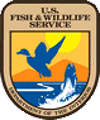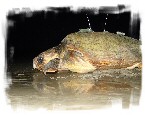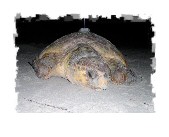The purpose of this study, being conducted by the Georgia Department of Natural Resources in conjunction with the University of Georgia-school of Forest Resources, National Oceanic and Atmospheric Administration, the United States Navy- Naval Submarine Base Kings Bay, The Environmental Resources Network (T.E.R.N.), National Fish & Wildlife Foundation, Cumberland Island National Seashore, Jekyll Island Sea Turtle Project, and The Wildlife Conservation Society, is to document inter-nesting habitat use, migratory pathways, and post-nesting movements of Georgia’s nesting loggerhead turtles using satellite telemetry. Loggerhead turtle movements will be compared with the distributions of commercial fishing and dredging activity and results will be used to make management recommendations to protect adult loggerhead sea turtles and their habitats.
During the first year of the study, the 2004 nesting season, satellite transmitters were deployed from Jekyll and Cumberland Islands.
During the second year of the study, the 2005 nesting season, researchers deployed satellite transmitters on Sapelo and Blackbeard Islands.
This tracking project also provides a unique educational opportunity for students to learn more about Georgia’s loggerhead turtles and the coastal marine ecosystems. During the spring of 2004, Sea Island, Georgia, will be the host of the historic G-8 Conference, where world leaders will meet to discuss important global economic issues. School kids from grades K-5 were given the opportunity to submit names for the turtles. In 2005, school kids from grades K-5 were given the opportunity to submit names for eight of the turtles. Over 240 Georgia students in kindergarten through fifth grade took part in the sea turtle naming contest. Click on each individual turtle to get more information.
This project will study the movements of Georgia’s adult loggerhead sea turtles during their nesting season (May-August), document their migratory movements and their foraging habitats (home range) and then we will make a comparison with known fishing activity in the area.
    |
     |
For more information on sea turtles, check out the Sea Turtles Information section of our website.
Click on the turtle’s name to see a map of its movements.
Turtles Tagged in 2005
| ATLANTICA – Atlantica was tagged on May 25, 2005 on Cabretta Beach, Sapelo Island – a VERY windy night! We had to constantly keep the tagging equipment from blowing away, and we were getting pelted with sand. Atlantica is a Sapelo Sound regular, and is often found in the same areas as Coral and Pearl, two of our other turtles. |
CORAL –  Coral was tagged in the wee hours of the morning on May 30, 2005 on Sapelo Island. She had a large bump on one of her vertebral scutes. Coral was found while laying a nest, which was very exciting for us to watch! Coral has been relatively easy to locate. She likes to spend time in Sapelo Sound with many of our other turtles. Coral was named by Christopher Aimager, a 5th grade student in Mrs. Alexander’s class at Early County Elementary School in Blakely, GA. Coral was tagged in the wee hours of the morning on May 30, 2005 on Sapelo Island. She had a large bump on one of her vertebral scutes. Coral was found while laying a nest, which was very exciting for us to watch! Coral has been relatively easy to locate. She likes to spend time in Sapelo Sound with many of our other turtles. Coral was named by Christopher Aimager, a 5th grade student in Mrs. Alexander’s class at Early County Elementary School in Blakely, GA. |
GYPSY –  Gypsy was the first turtle of four turtles tagged on Blackbeard Island. She was tagged on May 25, 2005. She has a few old wounds on her carapace that we couldn’t identify. We’ve been looking for this elusive girl in Sapelo Sound, which has been a “hot spot” for many of our turtles. The name “Gypsy” comes from the name of the steam-powered vessel used at the island during the yellow fever quarantine era of the late 1800s and early 1900s (about 1880 to 1910). It was used to shuttle doctors from their residences on the south end to the quarantine station on the north end of the island during the yellow fever epidemic. Gypsy was the first turtle of four turtles tagged on Blackbeard Island. She was tagged on May 25, 2005. She has a few old wounds on her carapace that we couldn’t identify. We’ve been looking for this elusive girl in Sapelo Sound, which has been a “hot spot” for many of our turtles. The name “Gypsy” comes from the name of the steam-powered vessel used at the island during the yellow fever quarantine era of the late 1800s and early 1900s (about 1880 to 1910). It was used to shuttle doctors from their residences on the south end to the quarantine station on the north end of the island during the yellow fever epidemic. |
PEARL –  Pearl is one of our most charismatic turtles! She has been easy to track, spending much of her time in Sapelo Sound. She likes to spend time on the surface. Pearl is missing a portion of her carapace, which was caused by a shark bite. But this old injury obviously hasn’t slowed her down! Pearl’s name was submmited by 3rd grade student Dalton Biggers from Mansfield Elementary in Mansfield, GA. Pearl was fitted with her transmitters on May 23, 2005 on Cabretta Beach, Sapelo Island. Pearl is one of our most charismatic turtles! She has been easy to track, spending much of her time in Sapelo Sound. She likes to spend time on the surface. Pearl is missing a portion of her carapace, which was caused by a shark bite. But this old injury obviously hasn’t slowed her down! Pearl’s name was submmited by 3rd grade student Dalton Biggers from Mansfield Elementary in Mansfield, GA. Pearl was fitted with her transmitters on May 23, 2005 on Cabretta Beach, Sapelo Island. |
SEA WEED –  Sea Weed is the television star of the 2005 tagging project! She was fitted with tags on May 26, 2005 on Sapelo Island, while being filmed by the Atlanta News Channel 2 crew with anchorman John Pruitt. Sea Weed is one of our largest turtles, and has an old boat prop wound on her carapace. The name Sea Weed was submitted by three different students. James Parker and Cody Simpson, 5th grade students at Union Point Elementary in Union Point, GA in Ms. Moon’s class submitted the name as well as Jackson White, a 4th grade student at the Montessori School of Covington in Ms. Melissa’s class. Sea Weed is the television star of the 2005 tagging project! She was fitted with tags on May 26, 2005 on Sapelo Island, while being filmed by the Atlanta News Channel 2 crew with anchorman John Pruitt. Sea Weed is one of our largest turtles, and has an old boat prop wound on her carapace. The name Sea Weed was submitted by three different students. James Parker and Cody Simpson, 5th grade students at Union Point Elementary in Union Point, GA in Ms. Moon’s class submitted the name as well as Jackson White, a 4th grade student at the Montessori School of Covington in Ms. Melissa’s class. |
ZAPALA –  Zapala was our 12th and final turtle tagged for the 2005 project. She was tagged on Memorial Day, May 30, 2005 on Sapelo Island. This was a special night as we hosted a “Community Night” and were joined by local children in our tagging efforts. Her name comes from the Guale Indian word for Sapelo. The kids helped clean her carapace and did a fantastic job getting her ready for her telemetry tags! Zapala was very calm and cooperative, and the kids were very excited to see her. Zapala was our 12th and final turtle tagged for the 2005 project. She was tagged on Memorial Day, May 30, 2005 on Sapelo Island. This was a special night as we hosted a “Community Night” and were joined by local children in our tagging efforts. Her name comes from the Guale Indian word for Sapelo. The kids helped clean her carapace and did a fantastic job getting her ready for her telemetry tags! Zapala was very calm and cooperative, and the kids were very excited to see her. |
Turtles Tagged in 2004
CHEREPAKHA –  Cherepakha was released on June 3, 2004 from Jekyll Island. Researchers recently encountered Cherepakha while she nested for the third time this summer. She had been at large for 27 days. Interestingly, she emerged and nested within 2 km of the site where she was originally tagged. Cherepakha is the Russian word for turtle. This name was submitted by Caden Jones of Clay Hill Homeschool in Lincolnton, GA. Caden has a friend who was a Russian missionary and went to him for inspiration. Cherepakha was released on June 3, 2004 from Jekyll Island. Researchers recently encountered Cherepakha while she nested for the third time this summer. She had been at large for 27 days. Interestingly, she emerged and nested within 2 km of the site where she was originally tagged. Cherepakha is the Russian word for turtle. This name was submitted by Caden Jones of Clay Hill Homeschool in Lincolnton, GA. Caden has a friend who was a Russian missionary and went to him for inspiration. |
CHEROKEE ROSE –  Cherokee Rose, released on May 26, 2004 from Cumberland Island, is one of the biggest turtles in our study at 101.5 cm curved carapace length. She has wandered further than expected during the internesting period including a trip to Florida (near St. Augustine)where she appears to have nested. Cherokee is one of the 3 nesting females tagged during our study with a large propeller wound on her carapace. The name Cherokee Rose was submitted by Taylor Konishi, 4th grader from Manning Oaks Elementary in Alpharetta, GA. Cherokee Rose is the official wildflower for the state of Georgia. Cherokee Rose, released on May 26, 2004 from Cumberland Island, is one of the biggest turtles in our study at 101.5 cm curved carapace length. She has wandered further than expected during the internesting period including a trip to Florida (near St. Augustine)where she appears to have nested. Cherokee is one of the 3 nesting females tagged during our study with a large propeller wound on her carapace. The name Cherokee Rose was submitted by Taylor Konishi, 4th grader from Manning Oaks Elementary in Alpharetta, GA. Cherokee Rose is the official wildflower for the state of Georgia. |
ONYXX –  Onyxx was released on June 18, 2004 from Cumberland Island. Onyxx was the smallest loggerhead turtle tagged during our study at 85 cm curved carapace length. She does not exhibit the strong site fidelity shown by some of the other turtles we are monitoring. Her internesting wanderings have taken her as far south as St. Augustine, Florida, before heading back north. Onyxx was released on June 18, 2004 from Cumberland Island. Onyxx was the smallest loggerhead turtle tagged during our study at 85 cm curved carapace length. She does not exhibit the strong site fidelity shown by some of the other turtles we are monitoring. Her internesting wanderings have taken her as far south as St. Augustine, Florida, before heading back north. |
ORMANDA –  Ormanda was released on June 18, 2004 from Jekyll Island. The name Ormanda was submitted by Karen Cole and Darlene Gunderman’s 2nd grade class from Kennesaw Elementary School in Kennesaw, GA. The name is of Germanic origin and means “of the sea”. Ormanda was released on June 18, 2004 from Jekyll Island. The name Ormanda was submitted by Karen Cole and Darlene Gunderman’s 2nd grade class from Kennesaw Elementary School in Kennesaw, GA. The name is of Germanic origin and means “of the sea”. |
TEA CAKE –  Tea Cake, released on June 3, 2004 from Jekyll Island, appeared to originally favor estuarine habitats, including St. Simons Sound near the Jekyll Island fishing pier and St. Andrews park on the south end of Jekyll Island, but has since headed away from her release point. Tea Cake is named for the traditional food served with afternoon tea, a favorite among residents of the United Kingdom. This name was submitted by Miss Maria Dixon, a 5th grade student of Mr. Harry Moss at Bethune Elementary in College Park, GA Tea Cake, released on June 3, 2004 from Jekyll Island, appeared to originally favor estuarine habitats, including St. Simons Sound near the Jekyll Island fishing pier and St. Andrews park on the south end of Jekyll Island, but has since headed away from her release point. Tea Cake is named for the traditional food served with afternoon tea, a favorite among residents of the United Kingdom. This name was submitted by Miss Maria Dixon, a 5th grade student of Mr. Harry Moss at Bethune Elementary in College Park, GA |
This project was funded by a grants from the U.S. Navy-Naval Submarine Base Kings Bay, National Oceanic and Atmospheric Administration, National Fish and Wildlife Foundation, and the Georgia Department of Natural Resources. Maps created by the Sea Turtle Conservancy.